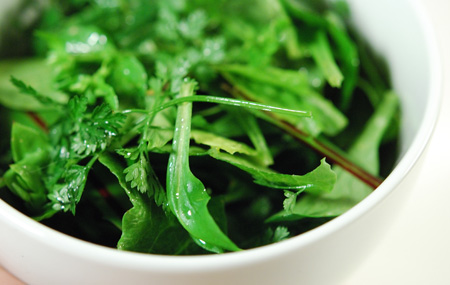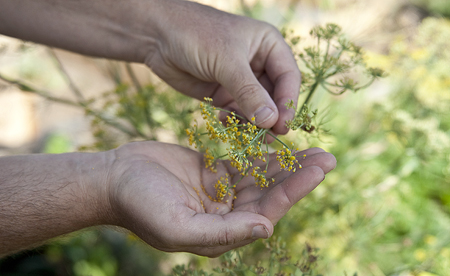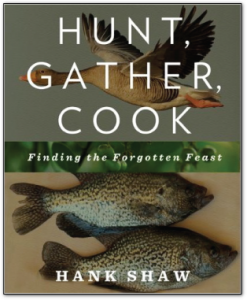Foraging can be as easy as eating the weeds around your house -- you’ll likely find dandelion, wild lettuce, chickweed, plantain, wild mustard and possibly wild onions and salsify root in vacant lots and yards around the Bay Area. Or, foraging can be as tough as digging giant geoduck clams (pronounced gooey-duck), which live three feet under the sand and are only accessible at extreme low tides a few times each year. Picking berries is easy. Picking owl limpets off storm-tossed rocks in Bodega Bay is not.
Foraging has become more popular over the past few years. Any ideas why?
People are yearning to be closer to their food, to know where it comes from and to eat with a sense of place on the plate. To eat abalone is to be Californian. To eat wild rice is to link yourself to the great Northwoods of Minnesota, Wisconsin and Michigan. Nothing is more local, more seasonal -- and, when done responsibly, more sustainable -- than incorporating wild food into your diet.
Foraging gets you out into the world, into the fresh air and into close contact with Nature. We are all so busy that maybe the simple act of hiking with a purpose provides the spark we need to get the hell away from the computer, whether it’s to bring back huckleberries for a pie or a deer for a full winter’s worth of meals. Foraging allows us to flirt with the wild.
I can walk nearly anywhere and spot edible plants and animals. Knowing that not everyone possesses that skill is a heady, powerful rush. I know I am not alone in that feeling, and many new foragers describe something similar to me when they find a good stash of nettles, or morels, or butter clams.
What can a Bay Area person find in their area? Any ideas for tasty things the average Joe or Jane should keep an eye out for?
"Yard weeds" are a great place to start. I wrote a primer on lawn foraging a while back that runs through the basics. Mostly these are salad greens, and right now is prime time for them all.
Blackberries are a good one. Everyone knows what they look like, and they are everywhere. Put on some gloves and get out there in July and August. We also have great huckleberry picking around here. Huckleberries are a lot like blueberries, only a little spicier, a little more tart. There are other berries around, too.
Fennel is another easy one. Fennel is native to the Mediterranean, but it was brought to California by Italian immigrants a century ago and has naturalized here. It is the same fennel you get in the store, only denser and more flavorful; it will not have big, fat bulbs, though.

Are there any dangerous foods that locals should avoid? What are your thoughts on the general dangers of foraging?
Everything has its dangers. Mushrooms, especially. I came very close to poisoning myself recently. I thought I had a fried-chicken mushroom: It met every descriptor, except the spore print. Had I been foolish enough to not take a spore print, who knows what might have happened? That said, chanterelles and morels are pretty easy to identify. Buy a good guidebook (I recommend David Arora’s All that the Rain Promises and More), learn it, and go slow.
This is also true for plants. There are lots of good guidebooks for West Coast foraging. Pick one up and study it, and then bring it into the field with you. Never eat something you cannot absolutely identify.
You will also meet up with ticks, bees, wasps, and, occasionally, rattlesnakes. It’s an occupational hazard. Bears and lions are around in the mountains, too, but they will not generally bother you. I’ve seen both animals several times while foraging. I gotta admit I was a little unnerved by the kitty, though.

Say a person wants to learn more about foraging before setting out on their own. Where should they go for more information? Should they take lessons or go on foraging walks? Where can they find such a thing?
I know that some people do conduct foraging walks, but I have not been on one since I was 11 years old -- and that was in New Jersey. I’d contact Iso Rabins with Forage SF for more on that one. As for me, I learned everything I know from experience, from books, and from being with knowledgeable friends. If you are into mushrooms, however, there are several excellent mycological societies around the Bay Area. Join one, go on a foray, and learn. It’s a cool experience.
 Can you tell us a little bit about your book? What topics does it cover? Will a Bay Area person be able to put it to good use? How about a person in other parts of the country?
Can you tell us a little bit about your book? What topics does it cover? Will a Bay Area person be able to put it to good use? How about a person in other parts of the country?
The book is called Hunt, Gather, Cook: Finding the Forgotten Feast, and it is intended as a guide and cookbook for anyone who wants to make wild foods part of their diet -- or for someone who already does fish, forage or hunt, this book will help expand their knowledge. A lot of people just forage, but don’t hunt or fish. A lot of hunters don’t know much about foraging, and a lot of anglers don’t understand hunting. This book brings it all together, with recipes at the end of each chapter. Some of those recipes are basic, like buttermilk fried rabbit, but others push the edges of wild game cooking, like wild boar liver crème caramel.
But I think the most important, the most unique piece of this book is the hunting section. Very few books have ever been written for adults who want to start hunting but have no idea how to go about it. Most intro-to-hunting books are geared for little kids. I include extended chapters on everything from hunting rabbits to deer to waterfowl, wild boar and upland game such as pheasants. Not a week goes by when I don’t receive an email from a reader of my blog who wants more information about how to start hunting. This book is an attempt to help.
As for the Bay Area, it is an integral part of my blog, Hunter Angler Gardener Cook, and since the book is an outgrowth of the blog, it follows that anyone living in the region will get a lot out of the book. There is not one chapter that is not relevant to someone living in NorCal.
That said, I have lived (and fished, hunted and foraged) in New Jersey, New York, Virginia, Minnesota and Wisconsin, and I have visited many other states in search of wild food. Just as there is no chapter that excludes California, no chapter excludes the rest of the country as well. Sure, there may not be highbush cranberries here in NorCal, but the Midwest doesn’t have manzanita or madrone. I write about all of them.

When does the book come out, and where can we get more information?
Hunt, Gather, Cook comes out May 26. It is already available for pre-order on the various online booksellers such as Amazon.com and Powell’s. Once the book is released, I will be setting up a series of events in the Bay Area and beyond -- cooking demos, readings, even fishing and foraging trips. You can get updated information about both the book and where I will be doing events on my blog, Honest-food.net, and by following me on Twitter under @Hank_Shaw.
Fennel and Tomato Pasta Sauce
By Hank Shaw, Hunter Angler Gardener Cook
Tomatoes and fennel pair well together, and this recipe is wonderful with the baby fennel that is sprouting all over the Bay Area right now. The sauce gets an added anise hit with a splash of Ouzo or Pernod, just to liven things up.
It is a great vegetarian sauce to serve with pasta, ideally a long pasta like spaghetti, bucatini or even homemade tagliatelle. Once you make the sauce, it will store in the fridge for 10 days or so. You can also freeze it.
Serves 6-8
Ingredients:
4 tablespoons olive oil
1 cup wild fennel, finely chopped
1/2 onion, finely chopped
1 garlic clove, chopped
1/4 cup ouzo or other anise-flavored liqueur
1 quart tomato sauce or crushed tomatoes
1 tablespoon honey
1 tablespoon mint or lemon verbena, chopped
Salt to taste
Pecorino cheese to garnish
Instructions:
1. Heat the olive oil over medium-high heat in a wide, deep pan or a large pot. When the oil is hot, add the fennel and onion and saute for 4-5 minutes, until the veggies are translucent. Don’t let the veggies brown — turn down the heat if you need to. Add the garlic and saute for another minute or two.
2. Pour in the ouzo and let this boil until it is reduced by half. Add the crushed tomatoes, honey and mint and mix well. Taste for salt and add some if needed. Let this simmer gently for 30 minutes.
3. Put the sauce into a blender or food processor and puree. Pour the blended sauce back into the pot and bring to a simmer. You’re ready to serve. This is a powerful sauce, so use less than you think you need at first.
 If there is ever a nuclear war or our food system completely falls apart, I'm heading to Hank Shaw's house. Besides being an avid hunter and gardener, Hank is a highly experienced forager -- which means that he's likely to be one of the few people who continue to eat well when the world is on its last legs (assuming we haven't destroyed all plant and animal life, too). Lucky for us, he chronicles his adventures on his blog, Hunter Angler Gardener Cook, and is about to release a cookbook/wild food guide, Hunt Gather Cook.
If there is ever a nuclear war or our food system completely falls apart, I'm heading to Hank Shaw's house. Besides being an avid hunter and gardener, Hank is a highly experienced forager -- which means that he's likely to be one of the few people who continue to eat well when the world is on its last legs (assuming we haven't destroyed all plant and animal life, too). Lucky for us, he chronicles his adventures on his blog, Hunter Angler Gardener Cook, and is about to release a cookbook/wild food guide, Hunt Gather Cook.


